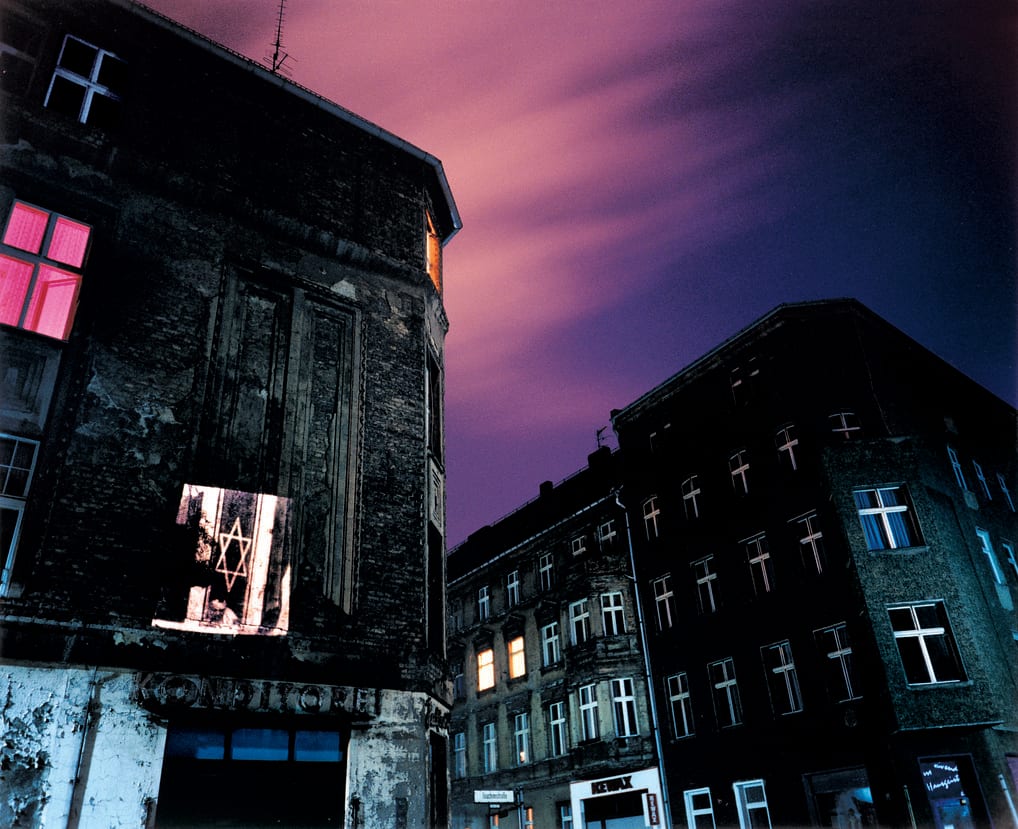
- Artist/Maker:
- Shimon Attie
- Bio:
- American, b. 1957
- Title:
- Joachim-Ecke Auguststrasse: Slide projection of former Jewish resident, 1931, Berlin
- Date:
- 1992
- Medium:
- Chromogenic color print
- Dimensions:
- Sheet: 20 × 24 in. (50.8 × 61 cm) Image: 17 3/4 × 21 3/4 in. (45.1 × 55.2 cm)
- Credit Line:
- Gift of David Kluger, by exchange
- Accession Number:
- 1993-174
Not On View
Like many of the more provocative artists of the last two decades, Los Angeles-born Shimon Attie works in a range of disciplines and media. Archivist, historian, political scientist, and pedagogue are but some of the roles he fills-all crucial to the themes explored and meanings produced in his ambitious projects. Aesthetically rich, Attie's art embodies a well-orchestrated amalgam of conceptual thinking and sculptural handling in which he collapses performance with site specificity, photography with light projection. His synthetic work can be linked to the playful "curatorial" interventions of the 1960s Belgian conceptualist Marcel Broodthaers and to the politically engaged institutional critique of his African-American contemporary Fred Wilson.
Attie also is an artist-anthropologist, a practitioner who digs into historical archives and then reconfigures his nonartistic material into prodigious works of public sculpture. His well-known projections are at once ephemeral and monumental. Yet the photographs that Attie creates to record these intensively staged projections go well beyond their original documentary purposes. Brilliantly colored, perfectly composed, and dramatically lit, they are beautifully crafted objects that play out in a more intimate scale the artist's investigation of the fragile negotiations between history and memory.
Berlin was the stage for Attie's breakthrough work of 1991-93, The Writing on the Wall, which emerged from his reaction to Germany's resuscitated capital. In the early wake of the unification of the bustling and formerly bifurcated city, a dark, brooding, and broken Berlin made a striking contrast with Attie's dizzying trajectory of pasts, both remembered and buried. As an American Jew, Attie became particularly interested in Berlin's Jewish past, but not in the Jewish past of its politically, socially, or economically prominent citizens. Those legendary heroes and heroines, with names like Mendelssohn, Benjamin, and Rathenau, had already become a cherished part of Berlin's and Germany's official history.
Instead, The Writing on the Wall concentrated on images of working-class Jewish life in Berlin's Scheunenviertel, the old ethnic neighborhood where the city's immigrant Eastern European Jews lived from the nineteenth century until World War II. Here Attie projected large-scale images of modest black-and-white historical photographs onto the dark and deteriorated architecture that surrounded the settings where domestic, religious, and entrepreneurial life once thrived. One of the best-known pieces in the series-perhaps the most formally sophisticated and politically loaded-is Joachim-Ecke Auguststrasse, a view of old Berlin apartment buildings in which we see, projected onto a bricked-over window, a Star of David that appears above the head of a praying man. This work shows how knowingly Attie transforms the images of his projections into photographs. Attie's worm's-eye view artificially creates crosslike forms from the transoms and mullions in the windows of the splay of looming buildings on the right. The subtle implication of the Christian religious symbol thus evokes the age-old conflict between the socially dominant Christian culture and a Jewish microcosm, while playing off a fleeting projection of memory and an enduring architectural reality.
Attie also is an artist-anthropologist, a practitioner who digs into historical archives and then reconfigures his nonartistic material into prodigious works of public sculpture. His well-known projections are at once ephemeral and monumental. Yet the photographs that Attie creates to record these intensively staged projections go well beyond their original documentary purposes. Brilliantly colored, perfectly composed, and dramatically lit, they are beautifully crafted objects that play out in a more intimate scale the artist's investigation of the fragile negotiations between history and memory.
Berlin was the stage for Attie's breakthrough work of 1991-93, The Writing on the Wall, which emerged from his reaction to Germany's resuscitated capital. In the early wake of the unification of the bustling and formerly bifurcated city, a dark, brooding, and broken Berlin made a striking contrast with Attie's dizzying trajectory of pasts, both remembered and buried. As an American Jew, Attie became particularly interested in Berlin's Jewish past, but not in the Jewish past of its politically, socially, or economically prominent citizens. Those legendary heroes and heroines, with names like Mendelssohn, Benjamin, and Rathenau, had already become a cherished part of Berlin's and Germany's official history.
Instead, The Writing on the Wall concentrated on images of working-class Jewish life in Berlin's Scheunenviertel, the old ethnic neighborhood where the city's immigrant Eastern European Jews lived from the nineteenth century until World War II. Here Attie projected large-scale images of modest black-and-white historical photographs onto the dark and deteriorated architecture that surrounded the settings where domestic, religious, and entrepreneurial life once thrived. One of the best-known pieces in the series-perhaps the most formally sophisticated and politically loaded-is Joachim-Ecke Auguststrasse, a view of old Berlin apartment buildings in which we see, projected onto a bricked-over window, a Star of David that appears above the head of a praying man. This work shows how knowingly Attie transforms the images of his projections into photographs. Attie's worm's-eye view artificially creates crosslike forms from the transoms and mullions in the windows of the splay of looming buildings on the right. The subtle implication of the Christian religious symbol thus evokes the age-old conflict between the socially dominant Christian culture and a Jewish microcosm, while playing off a fleeting projection of memory and an enduring architectural reality.
Information may change as a result of ongoing research.